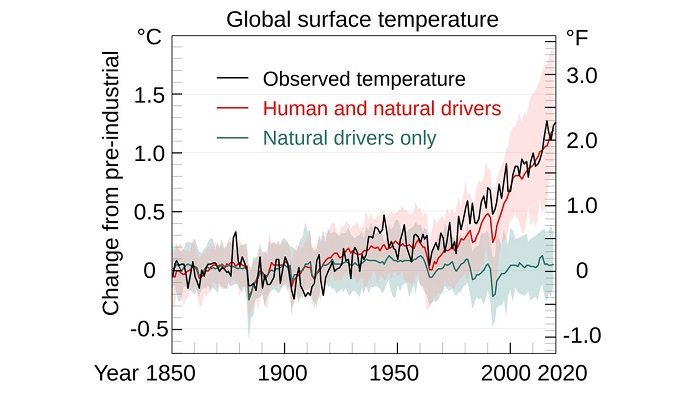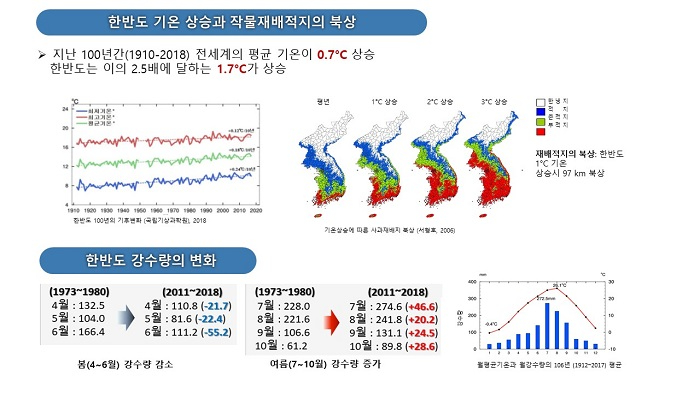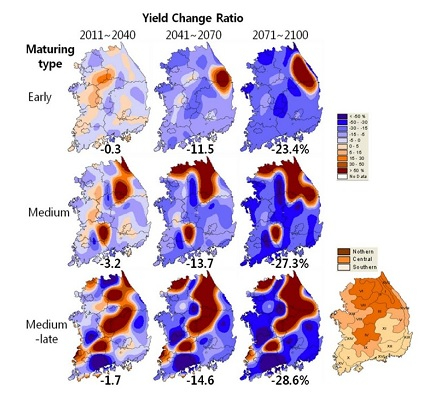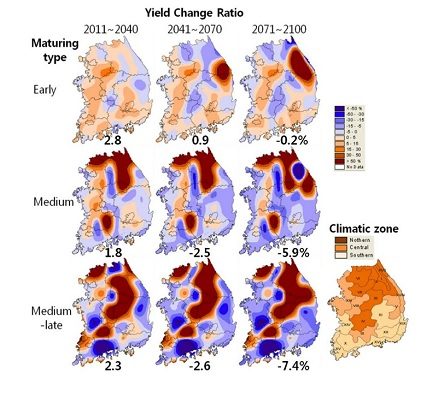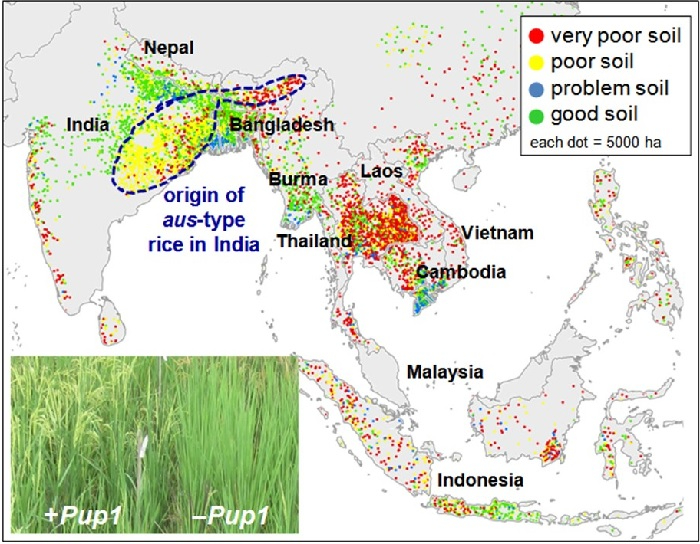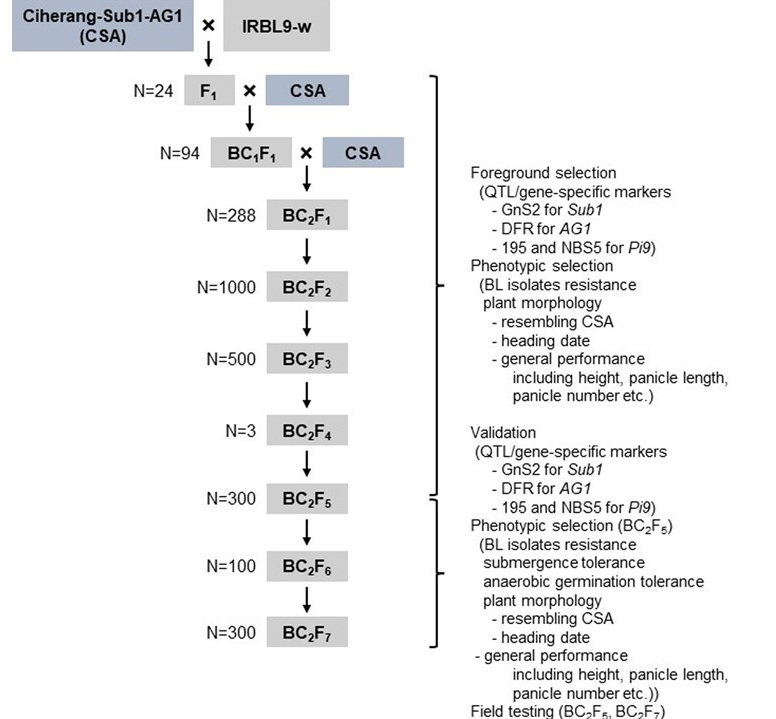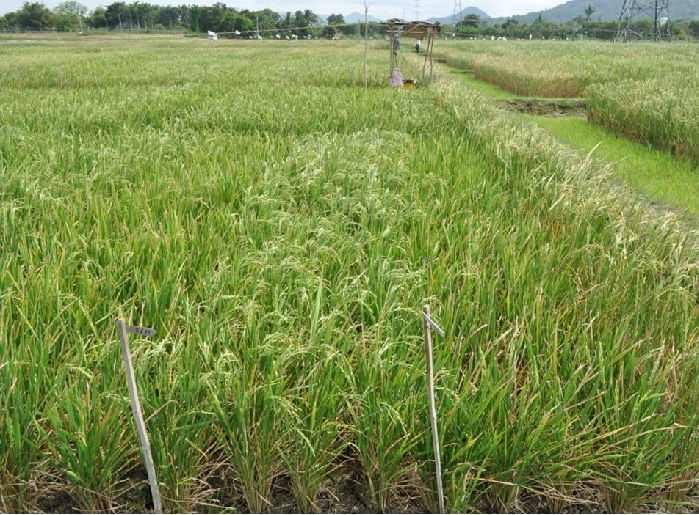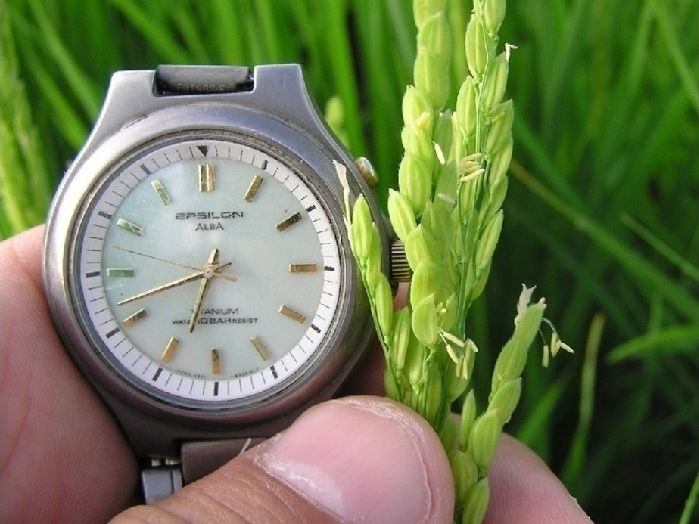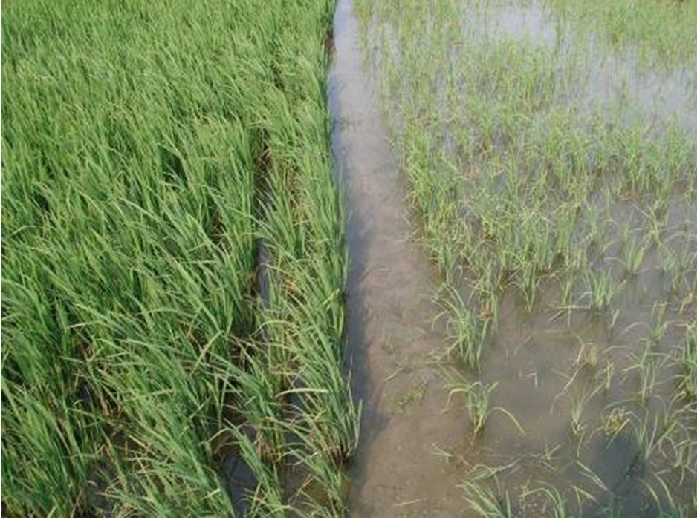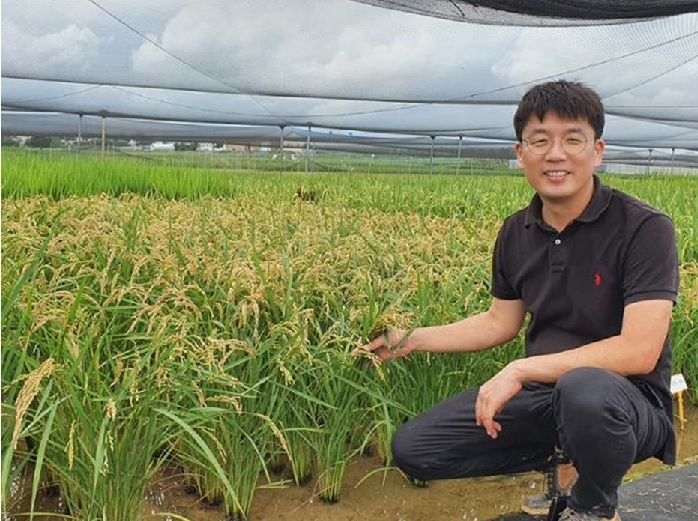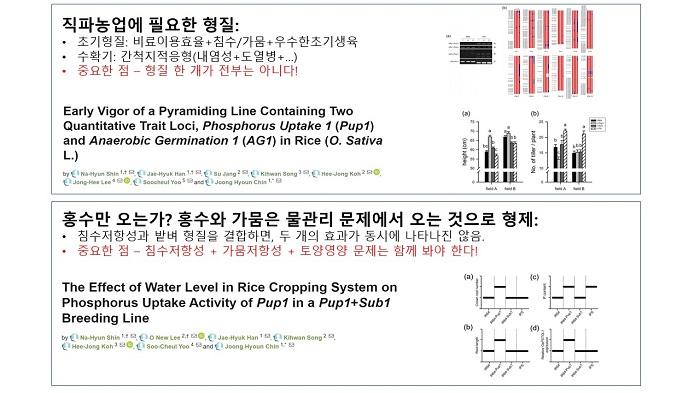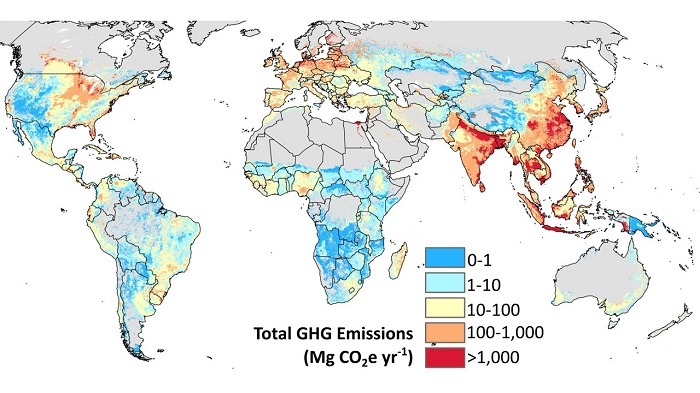SiteMap
close
Research
Research News
A prestigious global university that fosters Sejong-type talent who challenges creative thinking and communicates with the world.
|
Development and Utilization of Rice Varieties in Response to Climate Change 2023.10.12 152 |
|
|---|---|
|
Development and Utilization of Rice Varieties in Response to Climate Change Professor Chin Jung-hyoun Integrative Biological Sciences and Industry, Sejong University jchin@sejong.ac.kr 1. Preface Our future will be greatly affected by climate change, and in fact, we are already experiencing the climate change in various forms. We often see such news articles as ‘Ice of the Arctic is melting.’, ‘The tropical nights phenomenon (over 25 °C at night) is causing loss of sleep’, ‘Wild fires are occurring more frequently in the world,’ and ‘Farmers are having a hard time producing vegetables due to severe spring drought.’ Climate change is now very part of everyday discourse and has a major impact not only on human health and life, but also on agriculture and fisheries, our primary food sources. The 6th Report of the Intergovernmental Panel on Climate Change (IPCC), which regularly releases climate change reports, anticipates that the temperature of the earth will increase by 1.5°C in 2040, which is 10 years earlier than cited in the 5th report. This means the climate change continues to accelerate. The degree of climate change in Korea is greater than the average. According to Korean Climate Change Assessment Report 2020, the temperature of Korea is 1.9-2.6 times higher than the average. The bigger problem than the average temperature rise is that the climatic fluctuation range is getting wider. It is colder in winter and hotter in summer, with the spring and autumn disappearing. The temperature of May is especially increasing greatly, which becomes a major reason for spring droughts.
Figure 1. Climate change trends in Korea (Yonhap News, April 28, 2021)
Figure 2. Temperature rise on the earth surface Is mostly the result of industrial development (Source: IPCC 6th Report) 2. Climate Change and Agriculture. What if the earth becomes warmer by 6°C? How will climate change affect the production of animals and vegetables? Korea, whose main food crop is rice, expects a short term increase of production by with the rise in temperatures. However, although Korea’s main crop is still rice (as of 2021, the annual consumption of rice per capita is 56.9kg.), as dietary life diversifies and the proportion of nutrition supply shifts to meat, fish, and imported grains, and rice, it is hard to guarantee the stability of the food supply when coping with climate change. As of 2019, Korea’s food self-sufficiency is 21%. As Korea has a small land area, and the number of farmers in charge of producing crops has rapidly decreased (as of 2020, the total number of farmers in Korea is around 2.3 million, which is only 4.5% of total population.), we have the double burden of coping with climate change and innovating in production technology. If the temperature rises by 3°C to 6°C by 2100, all our current crops will either fail to flower or yield seeds. Recently, the number of pollinating bees is decreasing, which many researchers attribute to the effect of climate change. The world with 6°C higher temperatures will be catastrophic. Palm trees will be growing in Siberia, all tropical regions will be underwater, and there will be constant wild fires and tsunamis. It will not be easy to live on earth. 3. Will climate change cause food shortages? Ultimately, food shortages are a self-evident fact unless we change the current agricultural system, cultivation species, and farming areas, and unless we change our consumption behaviors. By 2060, it is said that the entirety South Korea will have a subtropical climate, and if the temperature rises by 1 degree, rice production will decrease by 150,000 tons. Considering that the rice yield of Korea in 2020 was 380,000 tons as bumper year, the decrease is about 4%. This means that with 6°C increase in temperatures, there will be about 30% decrease, but the reality might be much more severe than expected because seeds will not be generated if high temperatures continue during the blooming season. However, if the cultivation area is relocated or variety development is carried out according to climate change, the food loss is expected to be about 7%. These results show how important climate change predictions and food production technology research are. Since Korea imports most of its food, it cannot help being affected by the situations of other countries. There was a sudden crisis in 2020 when the whole world was suffering from COVID-19 and Korean economy is affected by the Russian-Ukrainian War. According to reports in April 2021, Sri Lanka, Peru, the Middle East, and several African countries are already experiencing governmental collapse because of soaring crude oil and grain prices. Korea, one of the advanced economies with developed democracy and capitalist economy, can systematically use various strategies to cope with rising costs, so there will be few immediate difficulties in this situation. But if this situation continues for more than two years, food production and distribution worsens, the import and supply of food crops in Korea cannot help but be greatly affected. Climate change is very gradual, and the future can be certainly predicted along with population, resources, and geographical location. It is hard to guarantee that Korea won’t be affected by the instability of global food crop production.
Figure 3. Trends in temperature rise and changes in suitable cropping areas on the Korean Peninsula over 100 years (top) and changes in precipitation on the Korean Peninsula over the past 50 years (bottom).
Figure 4. Prediction of rice yield as climate change progresses with no change of rice cultivation fields (Lee Chung-geun et al., Report of National Institute of Crop Science, 2013)
Figure 5. Prediction of rice yield as climate change proceeds after rice cultivation fields are changed (Lee Chung-geun et al., Report of National Institute of Crop Science, 2013) 4. Development of new rice varieties resistant to climate change There may be a way to relocate the cultivation area to respond to climate change, but it can be seen that developing varieties that adapt to various environmental changes due to climate change is the first and foremost course of action. The International Rice Research Institute, the world's foremost authority on rice and food agriculture supported by the Bill and Melinda Gates Foundation and US, German, European and multinational corporations, has produced many achievements in climate change response research. Korea has also succeeded in developing and commercializing tropical adaptive japonica rice (short grain temperate rice consumed in Korea and Northeast Asia) named ‘Asemi’ or ‘MS11’. Such countries as China, India, Japan and Korea as well as the International Rice Research Institute are developing various rice breeds to cope with climate change. Rice characteristics resistant to water submersion (FR13A, cultivar names in parentheses), dryness (Way Rarem, N22, Addday Sel, etc.), high temperatures (N22), salt damage (Pokkali, FL478, etc.), lack of fertilizer (Kasalath) are discovered, and new varieties are being developed by using molecular marker breeding methods for excellent varieties.
Figure 6. Eastern India and Bangladesh are rich in rice resources containing environmental stress resistance due to poor soil and various meteorological disasters (Gamuyao et al. 2012, Nature)
Figure 7. Ciherang, Indonesia’s representative cultivar, is resistant to submersion (Sub1), germinates even when submerged in water (AG1), and heat blast resistance (Pi9) from tropical regions using molecular marker-based backcross breeding (MABC). A new variety suitable for tropicalization and reclaimed land cultivation in Korea was developed (Shin et al. 2022, Rice, Professor Jin Joong-hyun's laboratory, Sejong University) Meanwhile, it is possible to develop breeds that avoid heat injury and various types of environment stresses by tropicalization, and the Chungcheongnam-do Agricultural Research and Extension Services has developed ‘Parmi’ and ‘Yeoreumi’, which can be harvested in 70 days not only to avoid heat injury but also to develop crop cultivation combination for increased rice yield. The Nippon Institute of Crop Science (NICS) in Japan has developed rice that blooms early in the morning from wild rice Oryza officinalis (Rice Koreans usually eat is Oryza sativa.), and this rice could allow us to avoid the high daytime temperatures.
Figure 8. Characteristic studies and varieties to develop rice resistant to environmental stress related to climate change (all photos below) Figure 8-1. Rice resistant to inundation (Sub1) Source: IRRI
Figure 8-2. Rice resistant to drought (DTY) Source: IRRI
Figure 8-3. Rice that requires less fertilizer (Pup1) Source: IRRI, Professor Chin Jung-hyeon, Sejong University
Figure 8-4. Rice that blooms in the morning to avoid high temperatures (EMF) Photo: NICS, Japan
Figure 8-5. Rice resistant to sea level rise (Saltol) Source: IRRI
Figure 8-6. Rice that can be harvest in 70 days after sowing. ‘Parmi’ and developer Dr. Yoon Yeo-tae (Hankook Ilbo Jul. 20, 2020) With the support of the Rural Development Administration and the National Research Foundation of Korea, Professor Joong-Hyun Jin's team at the Department of Smart Life Industry Convergence at Sejong University developed rice that is resistant to dryness, salt damage, and fertilizer input to MS11, a tropically adapted japonica rice variety. The team has also developed indica rice (long grain rice mostly cultivated in tropical and subtropical regions) that is resistant to climate change, and registered the breed jointly with Gyeongggi-do Agricultural Research & Extension Services, and farming corporations such as Haenam Ttangkkeut Loess Eco-friendly Farming Corporation are cultivating it, making efforts to help supply food at home and abroad. On the other hand, there will be a shortage of labor force for food production in the future, so direct farming using advanced agricultural machinery is essential. To maximize land use efficiency, it is necessary to concentrate main food production areas into reclaimed land on a large scale. Varieties needed in this environment need to be developed by collecting traits that are resistant to environmental stress, which is usually referred to as 'composite stress resistance', and it is very essential to develop advanced precision breeding technology to develop a large number of these varieties.
Figure 9. Varieties that are resistant to climate change must be evaluated in the actual field after combining related characteristics (traits) to suit the possible scenarios. Examples of considering fertilizer use efficiency, flooding, and drought characteristics together (Shin et al. 2021; Shin et al. 2020). 5. Developing rice suitable for greenhouse gas reduction farming methods Since Dr. Paul Crutzen won the Nobel Prize in Chemistry for citing greenhouse gases as the main factor causing climate change worldwide, eliminating greenhouse gases such as carbon dioxide and methane gas is the most important factor in 'carbon neutrality' in order to overcome climate change (https://www.gihoo.or.kr/netzero/intro/intro0101.do). Korea is a country that releases the greatest quantity of green-house gases from crop production, and agriculture accounts for 43.9% in total methane generation (26.7TgCO2eqyr-1). In agriculture, rice paddies account for 51.2%(6.0 TgCO2eqyr-1). Therefore, it is essential to develop agricultural methods that drastically reduce methane, and in Korea, the so-called 'Green Rice Project' was launched by a coalition of universities centered on the Food Science Institute of the Rural Development Administration (total research period of about 5 years from April 2022).
Figure 10. Calculation of total green-house gases generated for the production of 1kg of crops from the producer to consumer. The highest amount is in beef, and rice generates 3.6kg green-house gases mostly at farms.
Figure 11. World map for total green-house gases generated by the cultivation of crops. Korea is one of the countries in red color. (Carlson et al. 2017) While cultivating rice, there are soil characteristics such as soil redox potential, soil organic matter, soil temperature, soil acidity, and soil texture that should be considered as factors that generate methane. and agricultural materials for pesticides should also be considered. On the other hand, the ecology of various soil methanogens is studied, and environmental control for ecological control so that they emit less greenhouse gases is considered, but the relationship between soil and plants should also be studied in more depth. In order to reduce methane, delaying the time to trap water during rice cultivation or direct planting of rice in dry paddy fields can be helpful. On the other hand, it is known that it is relatively good to intensively manage organic matter in the soil and organic matter after harvest, and to perform minimal or no tillage. In addition, fertilizer input should be reduced, and soil conditioners may be effective. Developing new rice breeds can play a role in reduction of methane, but it is essential to use breeds suitable for methane reduction farming methods. The rice should be resistant to drying, adapt to direct seeding farming, have excellent root nutrient absorption, and have a short growth period. Usually, these varieties should have excellent initial growth after sowing, and accordingly, there will be differences in many parts such as plant shape, quantity, and community characteristics. 6. Conclusion Climate change has become a very common word. Most of us will witness the surface temperature of the earth increase over 3°C on average. Climate change will be the biggest variable in our lives, and things we take for granted now will be no longer around us. Problems with the emergence of new pathogens or sudden catastrophic outbreaks may become much more frequent. While human life itself requires a lot of changes, it is also demanding a big change in food agriculture due to the growing population, changes in consumption structure, and the decrease in agricultural population. With rice is especially important to develop new breeds suitable for methane reduction, and with enhanced resistance to environment stresses, diseases and pests. As the food self-sufficiency rate is as low as 20% in Korea, we should pay attention to other countries’ production and supply, and should consider food shortage and imbalance between supply and demand as a part of efforts of all human beings. This is the obligation required to Korea that has just entered the international society as one of leader countries. References Carlson K et al. (2017) Greenhouse gas emissions intensity of global croplands. Nature Clim Change 7, 63~68. https://doi.org/10.1038/nclimate3158 IPCC (2021) Masson-Delmotte, V.; Zhai, P.; Pirani, A.; Connors, S. L.; et al. (eds.). Climate Change 2021: The Physical Science Basis. Contribution of Working Group I to the Sixth Assessment Report of the Intergovernmental Panel on Climate Change. Cambridge, United Kingdom and New York, NY, USA: Cambridge University Press (In Press). Gamuyao et al. (2012) The protein kinase OsPSTOL1 from traditional rice confers tolerance of phosphorus deficiency. Nature. 488:535-539. Han et al. (2020) Genetic and phenotypic characterization of rice backcrossed inbred sister lines of saltol in temperate saline reclaimed area. Plant Breed Biotech. 8(1):58~68. Poore J and Nemecek T (2018) Reducing food’s environmental impacts through producers and consumers. Science. 360:987~992. Shin et al. (2020) Early vigor of a pyramiding line containing two quantitative loci, Phosphorus Uptake 1 (Pup1) and Anaerobic Germination 1 (AG1) in rice. Agriculture 10(10) Shin et al. (2021) The Effect of Water Level in Rice Cropping System on Phosphorus Uptake Activity of Pup1 in a Pup1+ Sub1 Breeding Line, Plants 8: 1523. Shin et al. (2022) Development of a temperate climate-adapted indica multi-stress tolerant rice variety by pyramiding quantitative trait loci, Rice 15:22. National Institute of Crop Science(2013). Investigation of rice yield and quality change and development of adjustment technique to climate change, Final report of Crop Test Research Project by Rural Development Administration. https://doi.org/10.23000/TRKO201300014018 Gwon Hyo-suk, Choi Eun-jeong, Lee Seon-il, Lee Hyeong-seok, Lee Jong-moon, Kang Seong-su (2022) Research Review of Methane Emissions from Korean Rice Paddies: Review. Journal of Climate Research 13(1): 117~134. Chin Jung-hyeon(2015) High Efficiency Molecule Breeding System Development Trend of International Rice Research Institute. The Journal of the Korean Society of International Agriculture, 27(5): 551~563. Climate Change PR Portal of the Ministry of Environment. https://www.gihoo.or.kr/netzero/intro/intro0101.do |
|
| Next | ON THE PROGENITORS OF BBHs IN GWTC-2 |
| Previous | Professor Sikandar Aftab Published Groundbreaking Research in the Prestigious Journal ACS Nano |

